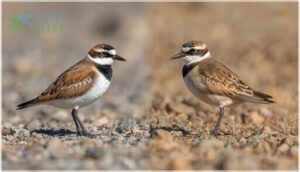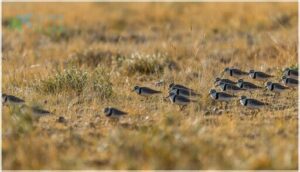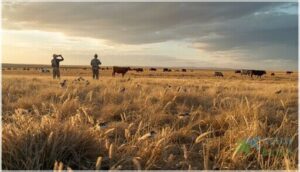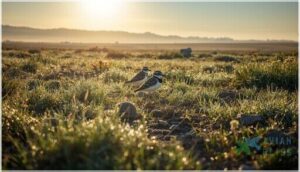This site is supported by our readers. We may earn a commission, at no cost to you, if you purchase through links.
 Don’t let the name fool you—the mountain plover won’t be found scaling rocky peaks. Instead, this bold little bird claims the wide, windswept prairies of the American West as its home.
Don’t let the name fool you—the mountain plover won’t be found scaling rocky peaks. Instead, this bold little bird claims the wide, windswept prairies of the American West as its home.
Where most shorebirds hug coastlines, the mountain plover breaks ranks, thriving in dry grasslands and open fields. You’ll spot its upright stance and sandy plumage blending into bare earth, often near prairie dog towns or overgrazed pastures.
Understanding how this species survives—and why its habitat is shrinking—gives you a fresh lens on the wild spaces that shape its future.
Table Of Contents
- Key Takeaways
- What is a Mountain Plover?
- Physical Characteristics of Mountain Plovers
- Mountain Plover Habitat Preferences
- Geographic Range and Distribution
- Behavior and Daily Activities
- Diet and Feeding Habits
- Breeding and Nesting Strategies
- Conservation Status and Threats
- Conservation Efforts and Management
- Where and How to Observe Mountain Plovers
- Frequently Asked Questions (FAQs)
- Where do mountain plovers live?
- Why is it called a mountain plover?
- What is a sand-colored mountain plover?
- What is a mountain plover in Oklahoma?
- How do I find a mountain plover?
- Do mountain plovers live in wetlands?
- What does a mountain plover look like?
- What is a mountain Pover?
- How many mountain plovers are left in the world?
- Are mountain plovers endangered?
- Conclusion
Key Takeaways
- Mountain Plovers live on open grasslands and depend on short vegetation, bare ground, and prairie dog towns rather than mountains or wetlands.
- The population has dropped by 80% since the 1960s, mostly from habitat loss, fragmentation, and changes in agricultural land use.
- These birds use bold breeding strategies like laying double clutches and rely on insects from the dry plains for food.
- Protecting Mountain Plovers now depends on restoring grasslands, supporting prairie dog colonies, and reducing land development to keep their wild spaces intact.
What is a Mountain Plover?
The Mountain Plover breaks all the rules you’d expect from a bird with its name. This species lives far from mountains and water, choosing instead the flat, open plains of the American West.
Understanding where it fits in the bird world and why early naturalists gave it such a misleading name helps you appreciate this unique shorebird that left the shore behind.
Taxonomy and Classification
The Mountain Plover, Charadrius montanus, stands alone within the family Charadriidae. Despite its geographic spread, genetic analysis reveals striking uniformity across populations, indicating no subspecies. This uniformity is a key aspect of its ornithological significance.
- Species identification relies on its classification within the Charadrius genus
- Genetic analysis shows no population subdivision despite geographic spread
- Phylogenetic relations link it to Caspian and Oriental Plovers
- Taxonomic history reflects ongoing conservation monitoring needs
Phylogenetic studies highlight its connections to Old World relatives, such as the Caspian and Oriental Plovers. The species’ conservation status is influenced by habitat loss factors, which pose significant challenges to its population.
Historical Naming and Misconceptions
You’ll find that this bird carries one of the most misleading names in North American ornithology. John Kirk Townsend first collected Charadrius montanus in 1834 along Wyoming’s Sweetwater River. John James Audubon then labeled it “Rocky Mountain Plover,” creating a misnomer that persists today. By 1895, fieldworkers confirmed the species avoids mountainous terrain entirely, preferring flat arid grasslands instead. The mountain plover’s habitat preferences are closely related to dry land ecosystems and their unique characteristics.
| Historical Period | Key Naming Event |
|---|---|
| 1834 | Townsend’s first collection in Wyoming |
| 1837 | Formal scientific description published |
| Late 1800s | Ornithologists document prairie habitat preference |
| 1895 | Fieldworkers confirm avoidance of mountains |
| Modern era | Conservation literature notes persistent misnomer |
The name’s Latin root, pluvia (meaning “rain”), references the bird’s seasonal return with spring rains. Despite taxonomic corrections removing “Rocky” from vernacular usage, the mountain association lingers in both common and scientific names, confusing observers expecting highland species characteristics.
Comparison to Other Plover Species
Understanding this species becomes easier when you compare it to its plover relatives. Mountain Plovers measure 21 to 23.5 cm—significantly larger than Piping Plovers (17–18 cm) and Semipalmated Plovers (18–19 cm). Unlike Killdeer with their bold breast bands, Mountain Plovers sport plain white underparts year-round.
Key differences that matter:
- Habitat Overlap is minimal—Mountain Plovers inhabit shortgrass prairies while Piping Plovers stick to coastal beaches
- Breeding Strategies vary—females lay double clutches with males incubating, unlike most plover species
- Species Comparison reveals conservation urgency—Mountain Plover populations declined 80% since the 1960s versus stable Killdeer numbers
- Plover Migration patterns differ—Mountain Plovers winter in tilled fields; Piping Plovers prefer Gulf coasts
- Conservation Genetics studies show distinct lineages—Mountain Plovers evolved for arid inland environments separate from shorebird relatives
Physical Characteristics of Mountain Plovers
You won’t find flashy plumage on a Mountain Plover, but you’ll notice something different about how they stand and move across open ground.
Their build tells you they’re made for wide-open spaces, not shorelines. Here’s what sets them apart when you’re scanning the grasslands.
Size, Shape, and Posture
You’ll spot the Mountain Plover’s elegant build right away. Adults measure 8–10 inches long and weigh just 3.6–4 ounces. Those long legs and elongated wings give them an upright, almost regal stance—more erect than the familiar Killdeer. Their rounded head and short, straight bill complete the look.
| Feature | Measurement |
|---|---|
| Body length | 20–25.4 cm (8–10 in) |
| Wingspan | 44–50 cm (17.5–19.5 in) |
| Weight | 90–110 g (3.6–4 oz) |
Both sexes share similar body proportions, with tarsus length averaging 3.5–4.5 cm. Field measurements confirm minimal size variations across populations, showing genetic consistency.
When alert, these birds hold their bodies at 70–85 degrees—a posture perfectly adapted for scanning open shortgrass prairie. Their morphometric trends reveal stability, making identification straightforward once you recognize those distinctively long legs and direct, level flight pattern.
Distinctive Coloration and Markings
You’ll notice the sandy-brown upperparts blend into a white throat and breast—perfect feather camouflage for dry plains. Here are key avian characteristics for visual identification of this bird species:
- Breeding adults sport a black forecrown and loral stripe from bill to eye
- In flight, watch for white wing linings and a thin white stripe on black wing tips
- Tail pattern shows a broad black band at the tip
This color pattern lacks the breast bands other plovers display, making Mountain Plover identification straightforward once you recognize these marking variations.
Seasonal Changes in Appearance
Mountain Plovers shift their plumage twice a year through distinct molt patterns. Breeding adults develop bold black forehead markings and golden-buff tones by mid-June.
Come fall, feather replacement strips away these breeding colors. The birds fade into drab winter plumage by late February.
These color shifts serve dual purposes—mate attraction during breeding season and effective camouflage strategies across barren winter grounds.
Key Identification Features
You can identify this shorebird by its upright stance and sandy-brown plumage patterns that lack breast bands. Look for the thin black beak and pale yellow-brown leg colors during any season.
In breeding months, watch for distinct head markings—a black line from bill to eye and dark forecrown. These field marks set Mountain Plovers apart from other plovers and shorebirds sharing grassland habitats.
Mountain Plover Habitat Preferences
Mountain Plovers don’t live in the mountains despite their name. These birds thrive in wide-open spaces where the grass grows short and the land stretches flat to the horizon.
You’ll find them in three main types of habitat across the western plains.
Shortgrass Prairie and Arid Plains
You’ll find Mountain Plovers thriving where grass barely reaches your ankle. These birds need shortgrass prairie with vegetation under 3 inches tall and at least 30% bare ground. Think of it as their sweet spot—open arid landscapes where they can sprint, forage, and spot predators from miles away.
Habitat fragmentation threatens these grasslands, making conservation strategies and proper grassland management critical for preserving prairie ecosystems and ensuring effective bird conservation.
Role of Prairie Dog Towns
Prairie dog towns are habitat engineering marvels you can’t ignore. These colonies create the bare ground and short vegetation plovers need for nesting. In Montana, plover density hit 7.2 birds per square kilometer on active colonies—that’s habitat gold.
Nest site fidelity runs high on colony edge effects zones. But here’s the catch: plague impact devastates both species. When prairie dogs vanish, plovers follow within two years. This population correlation makes grasslands conservation urgent for nesting success.
Use of Overgrazed and Agricultural Lands
You’ll find plovers thriving where livestock have hammered the grass down to stubble. Overgrazing benefits these birds by creating the bare soil mosaics they crave for nesting.
Agricultural fields now hold the population you’re trying to protect:
- Farmland nesting succeeds in 50% of attempts across crop selection zones
- Seasonal shifts bring 17% of the global population to Texas cropland each winter
- Habitat patchiness in grasslands drives conservation strategies linking overgrazed patches to sod farms
Habitat engineering happens whether we plan it or not.
Geographic Range and Distribution
Mountain Plovers roam across a surprisingly wide stretch of western North America, though you won’t find them everywhere within that range. Their movements follow the seasons, with distinct breeding and wintering territories that sometimes span hundreds of miles.
Understanding where these birds show up—and when—helps you appreciate just how much ground they cover in their quest for the right habitat.
Breeding Range in North America
You’ll find Mountain Plover breeding across the high plains from Alberta and Saskatchewan south to New Mexico and Texas. Colorado harbors around 11,000 breeders, while Wyoming and Montana host 3,400 and 1,600 respectively. Despite range expansion into Nebraska and Oklahoma, habitat fragmentation has triggered an 80% population decline.
Breeding success depends on site fidelity to prairie dog towns and grazed grasslands, though nesting in Mexico remains undocumented.
Wintering Grounds and Migration
After breeding ends in late July, you’ll witness flocks heading southwest through migration corridors toward winter territory. Approximately 85% congregate in California’s valleys and along the US-Mexico border.
Migration patterns reveal critical stopover habitats:
- Most birds arrive at wintering grounds by early November
- Texas hosts roughly 3,096 individuals
- The Chihuahuan Desert in Mexico harbors 8,200 plovers
- Spring migration to breeding areas begins late March
- Conservation challenges include fragmented migration corridors from cropland conversion
Avian migration patterns demonstrate population distribution across three key regions harboring 82% of wintering birds.
Regional Presence in The United States
Understanding where these birds actually live across the US shows you the full picture of their struggle. Breeding hotspots concentrate in Colorado and Wyoming, while California acts as the wintering epicenter for over 85% of the population. Texas concentrations support around 3,100 birds each winter in the Southern Texas Plains.
| Region | Season | Population Estimate |
|---|---|---|
| Colorado (Park County) | Breeding | 2,300 individuals |
| California (Imperial Valley) | Winter | 1,000–10,000 birds |
| Texas (Southern Plains) | Winter | 2,176 individuals |
| Wyoming (statewide) | Breeding | Second largest US population |
New Mexico and the broader Southwestern US host scattered groups, but isolated populations face severe threats. Population declines have reached 80% in recent decades. The US Fish and Wildlife Service tracks these losses carefully, working with state agencies to reverse the trend before it’s too late.
Behavior and Daily Activities
Mountain plovers move through their open grassland world with a rhythm all their own. You’ll notice they shift between bursts of quick running and sudden pauses, a pattern tied to how they hunt and interact with others.
Their daily life includes everything from solitary feeding to gathering in groups, along with the distinct flight styles that mark their territory.
Foraging Strategies and Movements
You’ll spot Mountain Plovers using a distinctive run-and-stop foraging technique—they dash forward, freeze, then snatch prey like grasshoppers and beetles from bare ground.
Their movement patterns are unpredictable, averaging about 3.5 km daily but sometimes covering over 300 km. This foraging behavior demands sparse vegetation and open soil, making prairie dog towns and heavily grazed rangelands essential for their energy acquisition and survival.
Flocking and Social Interactions
You’ll find Mountain Plovers gathering in impressive winter flocks—sometimes over 1,000 birds—across Texas and California croplands. Their Social Interactions reveal fascinating Flock Dynamics:
- Group Foraging: Loose aggregations form on tilled fields and sod farms
- Roosting Patterns: Night roosts attract hundreds on bare ground
- Low fidelity: Flock composition changes daily as birds move between sites
- Mixed ages: Juveniles and adults intermingle freely
- Migration Strategies: Premigratory staging increases local density
This Social Behavior enhances predator vigilance without stable bonds.
Flight Patterns and Territoriality
Mountain Plovers fly direct with rapid wingbeats at impressive altitudes—averaging 1,726 meters over land during migration. Their Flight Routes run southwest from breeding grounds, with Migration Timing starting late summer.
You won’t see strong Territorial Marking; these shorebirds defend only nest sites, not broader ranges.
Daily movements average 3.5 kilometers, but they’ll relocate up to 300 kilometers when Habitat conditions shift.
Diet and Feeding Habits
Mountain Plovers survive on a simple menu that matches their bare-bones lifestyle on the plains. What they eat shifts with the seasons and depends on where they’re feeding.
Let’s break down what fuels these birds through their days on the grasslands.
Primary Insect Prey
Ever wonder what keeps a Mountain Plover ticking out on the dry plains? Beetle consumption leads the way—these birds scoop up more than half their diet from beetles.
Grasshoppers, crickets, and ants add to the arthropod diet, showing off real insect diversity.
Foraging tactics matter: they run, pause, and peck, making prey selection a daily survival skill.
Seasonal Variations in Diet
Why stick to one menu when the prairie offers a buffet? As the months roll by, insect prey shifts—beetles dominate in spring, while grasshoppers and crickets take center stage by late summer.
Mountain Plovers show bold dietary adaptations, adjusting their feeding behavior to match seasonal food sources. This flexible arthropod composition is key to bird species characteristics and shorebird identification.
Feeding in Relation to Habitat
What shapes a plover’s menu? Habitat does. Your bird’s Feeding Behavior shifts with every landscape. Foraging Strategies in shortgrass prairies mean chasing grasshoppers. In plowed fields, beetle larvae fill the bill. Prey Abundance drives Nutrient Acquisition. Bird Behavior and Habitat are linked—watch these shorebirds adjust their Feeding Behaviors as Wildlife Habitat changes beneath their feet.
- Short vegetation aids prey detection
- Bare ground boosts foraging success
- Agricultural fields offer new insect sources
- Prairie dog towns increase chick survival
Breeding and Nesting Strategies
Mountain Plovers use some clever tactics to raise their young on the open plains. You’ll notice how their choices shape each step from eggs to fledglings.
Here’s a look at the main strategies they rely on.
Double-Clutch and Parental Roles
Did you know some Plovers pull off a double clutch, laying two sets of eggs each season? This bold breeding strategy splits parental care—males incubate one clutch, females the other.
It’s a dance of bird behavior and habitat, boosting chick survival and reproductive success. In wild avian species, flexible mating systems like this make every season an adventure.
Nest Site Selection and Construction
After the double clutch comes the search for the right spot. Mountain Plovers favor nest site preferences with bare ground selection—think patches with up to 72% exposed soil.
You’ll see their nesting habits reflect a shorebird’s bold spirit: shallow scrapes, microhabitat features like rocks or dung, and short grass. Habitat modification, grazing, and prairie dogs shape these nest construction techniques.
Chick Development and Survival
From bare ground to bustling chick activity, Mountain Plovers show bold nesting habits and rapid chick growth rates. Chick mortality runs high—predators, weather, and farming all play their part. Survival factors shift as fledging success depends on parental care and timing in the breeding season. Watch for these moments:
- Tiny hatchlings
- Quick weight gain
- Fierce predation
- Parental shading
- Flight-ready independence
Conservation Status and Threats
The Mountain Plover faces some tough challenges out on the plains. You’ll find the main threats and current conservation status laid out below. Take a look to see what’s putting pressure on this unique bird.
IUCN Listing and Population Trends
You’re looking at a bold and sobering bird species conservation story. The Mountain Plover sits on the IUCN listing as Near Threatened, with a Population Decline of about 2.5% each year. Threat Assessment highlights Species Vulnerability—especially in Endangered Species lists across North America. Here’s a snapshot:
The Mountain Plover’s conservation story is sobering: listed as Near Threatened, its population declines by 2.5% annually across North America
| Year | Global Population | Status | Decline Rate | Conservation Priority |
|---|---|---|---|---|
| 1966 | ~50,000 | Stable | — | Low |
| 1999 | ~18,500 | Threatened | 2.7% | High |
| 2010 | ~16,000 | Near Threatened | 2.5% | Very High |
| 2020 | ~15,500 | Near Threatened | 2.5% | Very High |
| 2025 | 15,000–20,000 | Near Threatened | 2.5% | Critical |
Habitat Loss and Fragmentation
The Mountain Plover’s story is written across broken landscapes. Habitat Destruction and Fragmentation Effects cut deep—grassland conversion, urban sprawl, and shrinking wildlife corridors leave little room for nesting. You see:
- Prairie dog towns vanish, erasing key microhabitats
- Large grassland ecosystems splinter into risky patches
- Ecosystem disruption threatens wildlife habitat preservation and long-term ecological conservation
Effects of Climate Change and Drought
Under a hotter and drier sky, Climate Impacts are disrupting the natural balance. Nest survival increases during droughts, but wild swings in rain and temperature pose threats to Population Dynamics. Habitat Shifts force plovers to adapt, putting Ecosystem Resilience to the test. For endangered species, Climate Change and drought push ecological conservation to its limits.
| Climate Impacts | Drought Effects | Habitat Shifts |
|---|---|---|
| Rising temps | Higher nest survival | Prairie loss |
| Variable rainfall | Adult survival up | Crop use |
| Storms intensify | Chick stress | Fragmentation |
| Habitat dries | Predator changes | Range moves |
| Food shifts | Water scarcity | New risks |
Conservation Efforts and Management
Protecting Mountain Plovers takes teamwork and smart planning. You’ll find a mix of strategies at work across the west. Here’s how people are tackling the challenge.
Habitat Restoration Initiatives
Ever wonder how you can tip the scales for wildlife preservation? Habitat restoration for Mountain Plovers hinges on Grassland Renewal, Prairie Dog Conservation, and Prescribed Burning. These strategies keep grass short, restore prairie dog towns, and boost breeding success.
It’s all about Ecological Balance and Sustainability—turning fragmented fields into thriving patches for Grassland Ecosystem Conservation and Wildlife Habitat Preservation.
Federal and State Protection Measures
Through a web of Conservation Laws and Protection Policies, your role in Biodiversity Protection is more essential than you think. Federal and state agencies weave Habitat Preservation into their daily Wildlife Management Practices. For instance:
- Seasonal restrictions limit disturbance during nesting
- Modified infrastructure reduces predator risks
- State Conservation Plans prioritize Species Protection under the Endangered Species Act and related Regulatory Measures
Research and Monitoring Programs
Ever wonder how you track a bird that blends into dusty fields? You rely on sharp fieldwork and smart technology. Collaborative networks tag and follow Mountain Plovers, using GPS and habitat monitoring to map their lives.
Population assessment drives conservation planning. Ornithological research feeds into every Conservation Plan, pushing Bird Conservation Efforts and Wildlife Management Practices to match real threats.
Where and How to Observe Mountain Plovers
If you’re hoping to spot Mountain Plovers, you need to know where and when to look. Their habits and habitats can surprise even seasoned birders.
Here’s what you should keep in mind before heading out.
Best Locations for Birdwatching
If you crave the thrill of spotting plovers, you’ll want to head where the birds and the land meet opportunity. Habitat Accessibility and Local Expertise make Colorado’s Pawnee National Grassland, Imperial Valley in California, and Santa Cruz Flats in Arizona prime birdwatching territory. Seasonal Migration shapes flock sizes, so Best Timing and Birding Etiquette will reward your search.
- Pawnee National Grassland, Colorado
- Imperial Valley, California
- Santa Cruz Flats, Arizona
Seasonal Viewing Tips
Want to catch a glimpse of grassland birds in action? Time your visits with migration patterns—early spring for breeding behaviors, late summer for post-breeding movement, and winter for flocks in open fields. Daily activity peaks midday when plovers forage on bare ground.
Viewing challenges include camouflage and shifting habitats, so adjust your search as habitat loss and conservation status shape their movements.
Ethical Birdwatching Practices
Spotting Mountain Plovers is a bold act, but your freedom ends where wildlife begins. Minimize disturbance—stay fifty meters from nests, avoid playback, and respect habitat boundaries. Report sightings discreetly, using sensitivity filters on platforms like eBird. Stick to trails, follow legal compliance, and promote awareness in your North American Birdwatching circles. The Audubon Field Guide echoes these bird conservation standards.
- Stay fifty meters from nests
- Use sensitivity filters for reporting
- Stick to marked trails
- Follow all legal requirements
Frequently Asked Questions (FAQs)
Where do mountain plovers live?
Imagine a horizon stretching flat and dry. Charadrius montanus claims open plains, shortgrass prairie, and overgrazed fields. Elevation preferences range from 4,000–7,200 feet.
Migration routes reach Mexico and California’s wintering grounds, shaped by land use and grassland ecosystem management.
Why is it called a mountain plover?
The Naming Misconception springs from Early Classifications and Historical Context. Charadrius montanus was dubbed “mountain” for its upland habitat, yet it’s a Plains Plover—more Prairie Ghost than peak-dweller, a true Habitat Paradox.
What is a sand-colored mountain plover?
Like a shadow melting into prairie dust, a sand-colored plover—Charadrius montanus—embodies cryptic plumage and color adaptations. Its plumage camouflage matches dry habitat, earning it the nickname “Prairie Ghost.”
Breeding colors add subtle avian characteristics.
What is a mountain plover in Oklahoma?
In Oklahoma, you’ll find this grassland bird nesting in agricultural fields and clay soils. Breeding activity is low but steady.
Conservation efforts focus on Endangered Species Protection, tackling habitat loss and fragmentation to support its survival.
How do I find a mountain plover?
It’s no accident that Habitat Identification and Seasonal Timing matter most.
Scan open grassland birds at sunrise with sharp Binocular Choice. Note Bird Size and Shape. Trust Local Guides.
Always practice Ethical Viewing—wildlife habitat needs respect, not disturbance.
Do mountain plovers live in wetlands?
Wetland Habitat Suitability is poor for these birds. Unlike typical shorebirds, they avoid wetlands, relying on dry grassland ecology.
Their nesting ecology, dietary differences, and low water dependency set them apart, highlighting unique wildlife habitat needs for species conservation.
What does a mountain plover look like?
You’ll spot this bird by its sandy plumage details, pale leg coloration, short black bill shape, and bold eye markings. Think robin-sized—about 3–1 inches. Its upright size shape stands out in ornithology species profiles.
What is a mountain Pover?
Back when disco ruled, the so-called Mountain Plover was misnamed—it’s a bird of dry plains, not peaks.
Avian taxonomy and classification place it among plovers, but its Plover Ancestry and measurements reveal unique species evolution and naming origins.
How many mountain plovers are left in the world?
There are only about 15,000 to 20,000 left today, a stark drop from earlier decades.
Population estimates show a historic decline—breeding numbers, wintering counts, and conservation impact all point to urgent species conservation and recovery for this endangered bird.
Are mountain plovers endangered?
Endangered birds face constant threats, and this species is no exception. Population decline continues due to habitat threats and climate impacts, placing its conservation status firmly among the most urgent concerns in bird species conservation. Despite recovery efforts and species protection, its survival remains precarious.
Conclusion
If you ever find yourself jealous of the mountain plover’s freedom, remember—this bird on the prairie dodges tractors, outsmarts coyotes, and nests in grass shorter than a buzz cut. Their daily survival isn’t some romantic bird ballet; it’s grit and timing.
When you picture the mountain plover now, think of a tiny rebel carving out space in the chaos. Protecting that spirit is about more than saving a species—it’s holding onto wildness itself.















